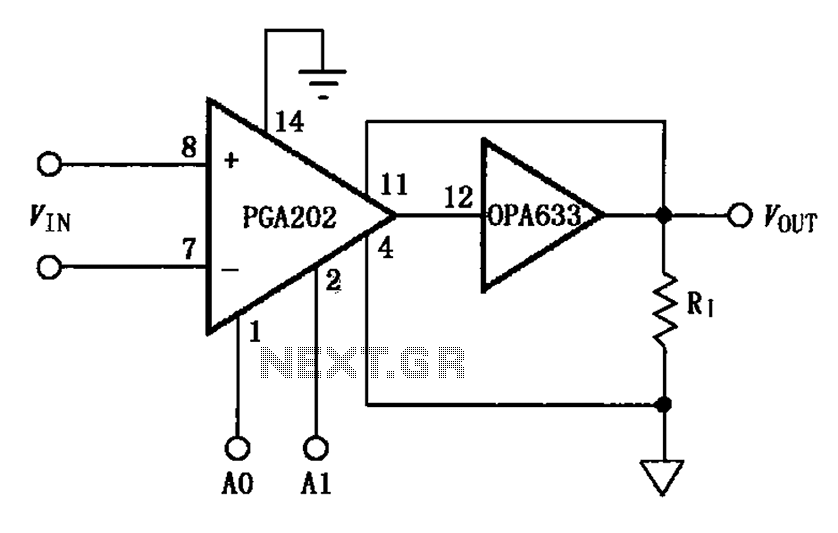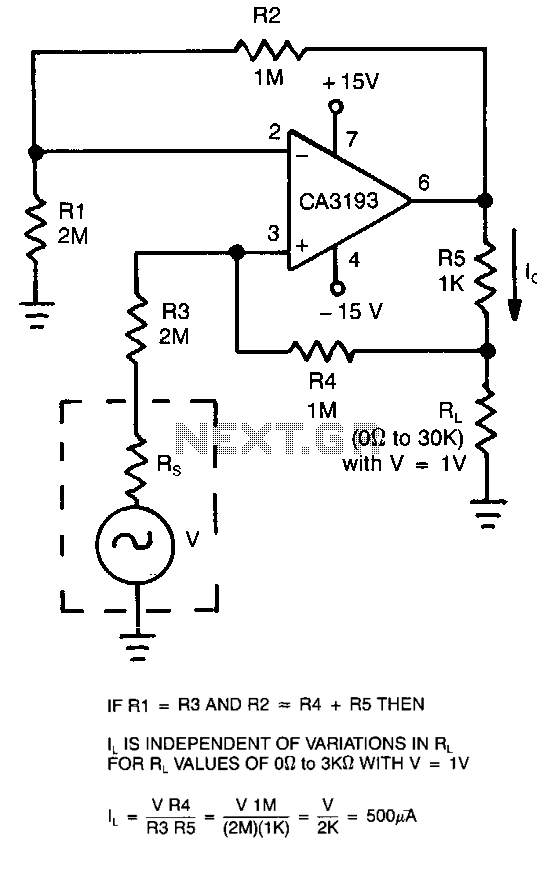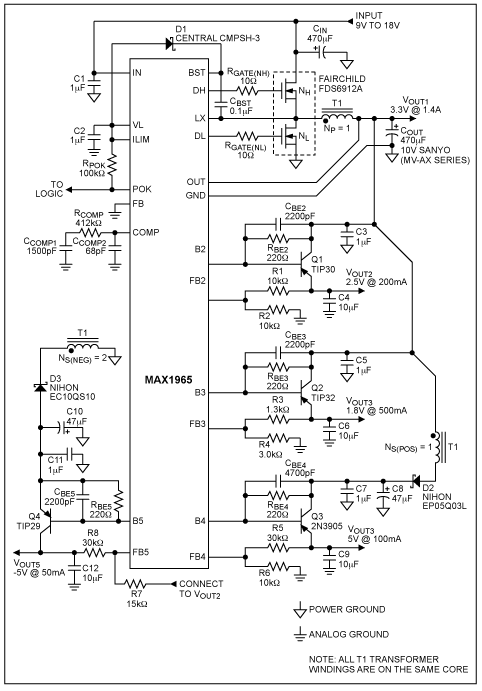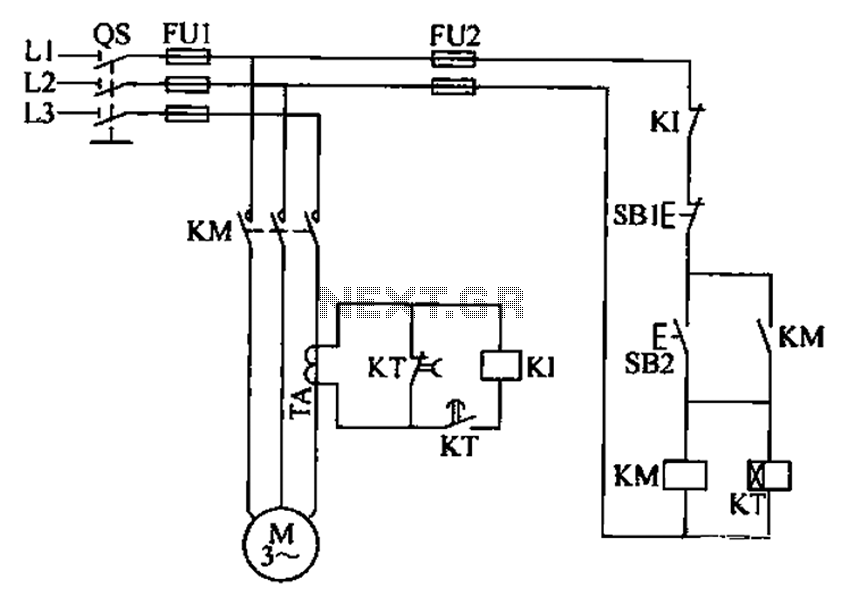
High Current Low Dropout Voltage Regulator
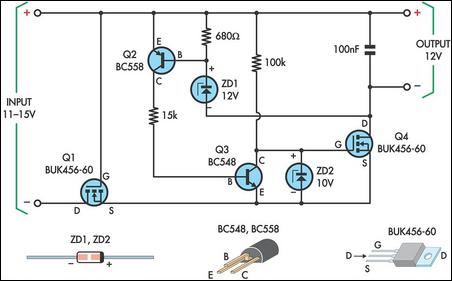
This circuit is designed to power a laptop computer using a solar power setup. The computer requires 12V at 3.3A. The circuit employs a linear regulator with a MOSFET (Q4) as the series pass device. A 100kΩ resistor provides Q4 with a positive gate-source voltage. If the output voltage exceeds the voltage of ZD1, Q2 activates, which in turn turns on Q3 to reduce the gate voltage of Q4, thereby decreasing the output voltage. The base-emitter voltage of Q2 stabilizes at approximately 0.35V, which, combined with the zener voltage, results in an output of 12.4V. For a more precise output, ZD1 should be selected with a voltage rating at least 0.4V lower than the desired output voltage. The output voltage can then be fine-tuned by adding a resistor in series with ZD1. The base-emitter voltage of Q2 and the 680Ω base resistor set the current through ZD1 to 0.5mA, indicating that the output voltage will increase by 0.1V for each 200Ω of resistance added in series with ZD1. Zener diode ZD2 protects against exceeding the maximum rated gate-source voltage of Q4. MOSFET Q1 provides reverse polarity protection, and while Q4 requires a heatsink due to a maximum dissipation of about 10W under worst-case conditions, Q1 does not require a heatsink. At 3.3A, the regulator only reduces the output voltage by 0.2V, and further output voltage reduction can be achieved by paralleling additional MOSFETs with Q1 and Q4.
The circuit utilizes a linear voltage regulation approach, leveraging the properties of MOSFETs to ensure stable output voltage despite variations in input conditions. The primary component, Q4, acts as the main regulator, controlling the voltage delivered to the laptop. The use of a 100kΩ resistor to drive the gate of Q4 ensures that the MOSFET remains in the appropriate operational region, providing effective regulation.
The feedback mechanism is crucial for maintaining the desired output voltage. ZD1, a zener diode, serves as a reference voltage source. When the output voltage approaches the zener voltage, Q2 is triggered, which activates Q3 to lower the gate voltage of Q4, thereby reducing the output voltage. This negative feedback loop ensures that the output remains stable at 12.4V under varying load conditions.
For applications requiring precise voltage levels, careful selection of ZD1 is essential. The recommendation to choose a zener with a voltage rating at least 0.4V lower than the output voltage allows for fine-tuning through the addition of a series resistor. This design consideration ensures that the circuit can accommodate slight variations in output voltage requirements without compromising performance.
The inclusion of ZD2 is a protective measure, ensuring that the gate-source voltage of Q4 does not exceed its rated limits, which could otherwise lead to MOSFET failure. The reverse polarity protection provided by Q1 is critical in preventing damage to the circuit in case of incorrect power supply connections.
Thermal management is addressed by requiring a heatsink for Q4, as the linear regulation process can lead to significant power dissipation, especially under maximum load conditions. The design anticipates a worst-case scenario where Q4 may dissipate up to 10W, necessitating proper thermal management to maintain reliability and efficiency.
In summary, this circuit effectively integrates several key components and design strategies to create a reliable power supply for a laptop from a solar power setup, ensuring stable operation, precise voltage regulation, and necessary protection against common electrical faults.This circuit was designed to allow a laptop computer to be powered from a solar power setup. The computer requires 12V at 3. 3A. The circuit is a linear regulator with Mosfet Q4 as the series pass device. A 100kO resistor provides Q4 with a positive gate-source voltage. Any tendency for the output voltage to exceed ZD1s voltage causes Q2 to turn on . This turns on Q3 which reduces Q4s gate voltage and thus reduces the output voltage. Note that Q2s base-emitter voltage stabilizes at about 0. 35V. This combined with the zener voltage gives an output of 12. 4V. If a more precise output is required, first select ZD1 so that its voltage rating is at least 0. 4V less than the required output voltage. You can then "trim" to the required output voltage by installing a resistor in series with ZD1. Q2s base-emitter voltage and the 680W base resistor set the current through ZD1 to 0. 5mA. This means that the output voltage will be boosted by 0. 1V for each 200O of resistance in series with ZD1. Zener diode ZD2 ensures that Q4s maximum rated gate-source voltage is not exceeded. Mosfet Q1 provides reverse polarity protection. Note that Q4 requires a heatsink since it will dissipate about 10W under worst-case conditions. No heatsink is required for Q1. At 3. 3A, the regulator reduces the output voltage by just 0. 2V. This can be further reduced by paralleling Q1 & Q4 with additional Mosfets. 🔗 External reference
The circuit utilizes a linear voltage regulation approach, leveraging the properties of MOSFETs to ensure stable output voltage despite variations in input conditions. The primary component, Q4, acts as the main regulator, controlling the voltage delivered to the laptop. The use of a 100kΩ resistor to drive the gate of Q4 ensures that the MOSFET remains in the appropriate operational region, providing effective regulation.
The feedback mechanism is crucial for maintaining the desired output voltage. ZD1, a zener diode, serves as a reference voltage source. When the output voltage approaches the zener voltage, Q2 is triggered, which activates Q3 to lower the gate voltage of Q4, thereby reducing the output voltage. This negative feedback loop ensures that the output remains stable at 12.4V under varying load conditions.
For applications requiring precise voltage levels, careful selection of ZD1 is essential. The recommendation to choose a zener with a voltage rating at least 0.4V lower than the output voltage allows for fine-tuning through the addition of a series resistor. This design consideration ensures that the circuit can accommodate slight variations in output voltage requirements without compromising performance.
The inclusion of ZD2 is a protective measure, ensuring that the gate-source voltage of Q4 does not exceed its rated limits, which could otherwise lead to MOSFET failure. The reverse polarity protection provided by Q1 is critical in preventing damage to the circuit in case of incorrect power supply connections.
Thermal management is addressed by requiring a heatsink for Q4, as the linear regulation process can lead to significant power dissipation, especially under maximum load conditions. The design anticipates a worst-case scenario where Q4 may dissipate up to 10W, necessitating proper thermal management to maintain reliability and efficiency.
In summary, this circuit effectively integrates several key components and design strategies to create a reliable power supply for a laptop from a solar power setup, ensuring stable operation, precise voltage regulation, and necessary protection against common electrical faults.This circuit was designed to allow a laptop computer to be powered from a solar power setup. The computer requires 12V at 3. 3A. The circuit is a linear regulator with Mosfet Q4 as the series pass device. A 100kO resistor provides Q4 with a positive gate-source voltage. Any tendency for the output voltage to exceed ZD1s voltage causes Q2 to turn on . This turns on Q3 which reduces Q4s gate voltage and thus reduces the output voltage. Note that Q2s base-emitter voltage stabilizes at about 0. 35V. This combined with the zener voltage gives an output of 12. 4V. If a more precise output is required, first select ZD1 so that its voltage rating is at least 0. 4V less than the required output voltage. You can then "trim" to the required output voltage by installing a resistor in series with ZD1. Q2s base-emitter voltage and the 680W base resistor set the current through ZD1 to 0. 5mA. This means that the output voltage will be boosted by 0. 1V for each 200O of resistance in series with ZD1. Zener diode ZD2 ensures that Q4s maximum rated gate-source voltage is not exceeded. Mosfet Q1 provides reverse polarity protection. Note that Q4 requires a heatsink since it will dissipate about 10W under worst-case conditions. No heatsink is required for Q1. At 3. 3A, the regulator reduces the output voltage by just 0. 2V. This can be further reduced by paralleling Q1 & Q4 with additional Mosfets. 🔗 External reference
